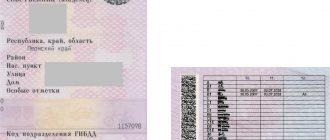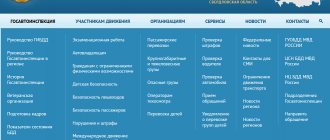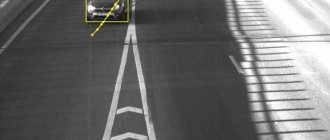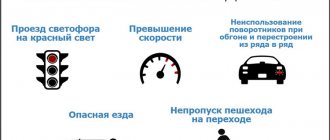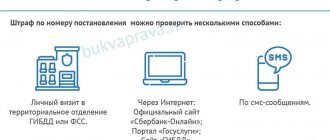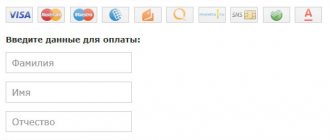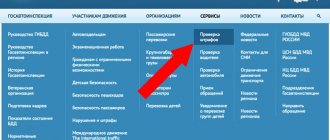How traffic police fines are recorded with photos
How cameras and traffic police officers work. Let's look at the most common case - the camera looks at the lane and records violations: for example, driving into oncoming traffic. As soon as the car is in the oncoming lane, the camera sees that the car is driving against the main flow and takes a series of photographs or video recordings.
After this, the materials are sent to the Center for Automatic Recording of Administrative Offenses (CAFAP), a division of the traffic police. There, the inspector checks from photographs whether the driver really violated and whether the camera made a mistake. If a traffic police officer accepts the driver’s actions as a violation, he signs the resolution and sends it to the traffic police database.
Then the information goes to the information system on state and municipal payments (GIS GMP). This is the information base of the Russian Treasury; it stores all information about payments that have been received or should be received by the treasury. Fines, taxes, penalties from bailiffs - everything is in this database.
Within 3 days, the car owner is sent a decision by mail or he himself checks his fines online and sees a new one.
Why is there not always video recording? The number of photo and video materials and their shelf life depend on the technical equipment of TsAFAP - it is different in each region. For example, in Moscow there is a budget for the purchase and maintenance of large data servers. A server is a powerful computer with a large amount of memory. The more servers, the more opportunities to store photos and videos and do it for a long time. Therefore, in Moscow and the region, even video recordings are stored for up to 3 years.
But if a region has purchased small-volume servers, photos may not be stored for long: in regions this period is often from a week to six months. In this case, the video recording may not be saved at all.
What types of cameras are there? Most often, cameras are installed on supporting structures - poles, overpasses, bridges. There are other ways of arrangement. Let's look at them all:
- stationary - the camera is mounted on a pole or a special mast. Usually located in the city or on busy roads;
- mobile - the camera stands on a tripod. Inspectors install it when they check cars in remote areas of the region - where it is inappropriate to install a stationary camera;
- transportable - the camera is installed on public transport or a special car. This method is almost always used to check whether parking has been paid and whether there are violators in the public transport lane.
Methods of installing cameras: on a pole, tripod, in a special vehicle. Source: simicon.ru
Public transport or special vehicles are equipped with cameras that record violations of parking rules and traffic in designated lanes. Source: simicon.ru
How to check MADI fine online
To check, you need to visit the fines checking page on the Moscow Mayor’s website (https://www.mos.ru/pgu/ru/application/gibdd/fines/#step_1). In the special form on this page, enter the series and number of the driver's license (V/U) or vehicle registration certificate. Based on this data, the system will give you all the fines and protocols drawn up by the MADI employee. If the fine sent to you from MADI is not in this database, it means that the fine was sent by scammers.
Considering that Moscow is not only the capital, but also a city of federal significance, fines for violating the rules of parking, parking and stopping cars there are many times higher than the national average. This is what scammers take advantage of, issuing multi-thousand-dollar fines on behalf of MADI employees and indicating their details.
Why is photographic recording of the violation necessary?
The camera can monitor the traffic situation 24 hours a day all year round. The inspector does not notice many violations while drawing up a protocol, warming up in the car or having lunch. Here are some more reasons to use cameras.
Objective recording of violations. The camera records what appears to be a violation. Whether this was actually a violation is decided by the traffic police officer. He will look at all available materials and make a decision. If there is still a violation of the rules, the inspector will issue a fine.
Ability to control more roads. The camera can be placed on remote sections of roads with extreme weather conditions.
Recording several violations at once. All traffic cameras have this function. For example, cameras of the Cordon model can simultaneously detect:
- over speed;
- driving into the oncoming lane or tram tracks in the opposite direction;
- driving on the median;
- driving in the public transport lane;
- driving on the side of the road;
- driving trucks where prohibited;
- passing through the stop line.
Makes it easier to find violators and bring them to justice. There are cameras that are configured to search for specific cars by license plate number. The traffic police patrol uses them to track the movement of the offender’s car.
The opportunity to prove your innocence. The inspector rarely looks at all the photos, much less the video from the camera: he doesn’t have time for that. And sometimes the camera makes mistakes - it incorrectly measures the speed or calculates the license plate number of the car.
The camera sends a series of photos or video recordings to the server. If the camera or inspector makes a mistake, the driver can request the entire series of photos or videos that show the mistake and prove his innocence.
Photo recording of traffic offenses
The current technology for calculating traffic police fines from video recording cameras is extremely clear and simple. External surveillance cameras record traffic violations around the clock using a special program. The data flows into an automated information center, where it is systematized and processed accordingly. Then the information is specified for each offender and, as a result, the final document appears - a notice of administrative punishment.
The process has been worked out quite thoroughly in large cities and there are practically no failures, although the cases are completely different. At this stage of development of the “traffic fines and photo recording” system, it has been possible to largely eliminate the human factor and corruption component. However, the life of Russian drivers has not become better, but, on the contrary, has become noticeably more complicated.
Photo recording of the speed limit is carried out around the clock
What violations are recorded by cameras?
The capabilities of the camera depend on the customer of the equipment - the city administration. If the area is hazardous or several traffic rules are violated at once, the customer asks to enable one or another function on the camera.
Here is a complete list of violations recorded by traffic cameras:
- driving on red;
- driving in reverse;
- leaving the stop line;
- violation of traffic rules through a railway crossing;
- turning from the second row - failure to comply with the rules of maneuvering;
- driving on the side of the road, sidewalk, bike path;
- over speed;
- driving into the oncoming lane;
- driving in the public transport lane;
- violation of parking rules;
- non-payment of parking;
- not allowing pedestrians to pass;
- violation of transportation of oversized cargo.
In Moscow, from the beginning of 2021, the traffic police began testing cameras that can track violations: unfastened seat belt, lack of compulsory motor liability insurance policy and talking on the phone.
Established inspection deadlines
Most photo and video cameras are designed to record speed violations or other actions - for example, driving into the oncoming lane or not wearing a seat belt, running a red light, etc.
The installation recognizes the license plate, and then after a few days fines are sent to the violator’s postal address, based on the data received in the traffic police database from video cameras. Such letters are popularly called “letters of happiness.”
Such shipments contain a receipt for a fine that must be paid. It also contains the following information:
- Place of the event, its time and date;
- A transcript of a specific violation has been made;
- Amount of contribution to be paid.
The purpose of most installed speed cameras is to photograph and record violations of the speed limit. It is important that during such registration, the culprits, as a rule, receive a minimum fine, which will come in the coming days.
What to do if the deadline is over?
In order to check and, if necessary, appeal the order, the motorist has no more than 10 days at his disposal, and the permissible period for payment of the amount in the received receipt is 2 months.
Some people forget that the fine must be paid; it also happens that the car owner forgets about the very existence of the order. This should not be done: if you do not meet the established payment deadlines, you may subsequently have to pay twice as much (at least 1000 rubles), or even receive arrest for up to 15 days, or community service for up to 50 hours. An article regulating this is present in the Code of Administrative Offenses.
Rules for imposing traffic police fines with photo recording
Minimum possible fine. The Code of Administrative Offenses (CAO) often has a range of fines for one violation. For example, for failure to allow a pedestrian to pass, the minimum fine is 1,500, the maximum is 2,500 rubles. If the violation was noticed by a camera and not an inspector, the fine under the Administrative Code will be minimal.
Deadlines for issuing traffic fines with a photo of the violation. The traffic police officer is obliged to make a decision on photo or video materials within 15 days from the day he receives them.
Payment of traffic fines with a 50% discount
In accordance with the Federal Law of the Russian Federation dated December 22, 2014 N 437-FZ, amendments were made to the Code of Administrative Offenses. From January 1, 2016, you have the right to pay a fine for violating traffic rules in the amount of 50% of the amount of the fine imposed.
Part 1.3 has been added to Article 32.2:
1.3. When an administrative fine is paid by a person held administratively liable for committing an administrative offense provided for in Chapter 12 of this Code, with the exception of administrative offenses provided for in Part 1.1 of Article 12.1, Article 12.8, Parts 6 and 7 of Article 12.9, Part 3 of Article 12.12, Part 5 of the Article 12.15, part 3.1 of article 12.16, articles 12.24, 12.26, part 3 of article 12.27 of this Code, no later than twenty days from the date of the decision to impose an administrative fine, an administrative fine may be paid in the amount of half the amount of the imposed administrative fine. If the execution of the decision to impose an administrative fine was delayed or spread out by the judge, body, or official who issued the decision, the administrative fine is paid in full.
What to do if you receive a fine without a photo
Why do fines arrive without photographs? This happens if the fine comes for violating parking rules. In all regions except Moscow and the Moscow region, there is no photograph in the resolution for this violation. Sometimes a photo does not get into the GIS GMP due to a technical failure. Read more about all the cases when a dubious fine is received in our detailed analysis.
Where to check traffic police fines online with photos. This can be done on the State Services website, but you need to register and confirm your identity, and to do this go to the MFC. Instead, check the fine on the Traffic Police Fines website.
You will need a license plate number, registration certificate and license numbers. Leave your email so you don't miss notifications about new fines.
Is it possible to check online by the name of the car driver?
Car owners have the opportunity to view the availability of fines in various ways (for example, through the government services portal, on the official website of the traffic police, etc.).
However, for most of these services you need to provide details of your driver’s license or car registration certificate (read about how to check fines using your driver’s license details here, and how to check fines using your STS number here).
The only available option to check yourself for debt using your passport data is the website of the Federal Bailiff Service (FSSP).
Why is it impossible to find unpaid administrative debts according to the passport of a citizen of the Russian Federation?
There are several reasons why checking administrative debt using the initials of the car owner (last name, first name, patronymic) is a rather rare occurrence:
- The full name does not allow one to absolutely accurately identify a particular person. The fact is that in life there can be quite a large number of namesakes. Moreover, even indicating the date of birth does not always allow one to identify a specific person.
- Checking traffic police fines by initials makes such information publicly available regardless of the will of the driver.
Additionally, it should be noted that today there is no need to create other services that would allow you to find out about the presence of traffic police fines based on the car owner’s passport data. Current programs quite successfully solve this issue (what programs are there to search for fines?).
What are the consequences of unpaid traffic police fines with photos?
The case will be handed over to the bailiffs. This will happen 70 days from the date of the decision if the fine is not paid. They give you 10 days to appeal the fine and 60 days to pay. The date can be viewed when checking.
In the upper left corner is the date of the decision, below is the date of violation
The fine will be increased by 1000 rubles. When the FSSP employee receives a copy of the resolution, he will begin enforcement proceedings. A decision about this will be sent to the driver - you can check it at the State Registration Office. If the driver receives a decree and does not pay the fine after 5 days, the bailiff will issue an enforcement fee - 7% of the debt amount, at least 1000 rubles.
Now the driver must pay the fine, plus a fee - he has another 70 days to do this. In this case, you no longer need to pay a fine to the traffic police - only to the bailiffs by their order. This document will also be reflected when checking on the “Fines” website.
For a bailiff's fine, the resolution number begins with the numbers 322
They will withdraw money from the account. This is possible if the driver ignores the order of the bailiffs and does not pay the fine. In this case, the bailiffs refer the case to court. If the debtor does not appear at the meeting, the decision will be made without him, and not in his favor. The judge, after considering the case, can make one of several decisions. Most often, money is forcibly collected from a bank account.
Rights are revoked. This measure can be chosen for the debtor if the debt is more than 10,000 rubles.
Movement will be restricted. Such a sanction may be applied if the debt is more than 30,000 rubles.
They will be arrested or ordered to work. At the meeting, they may be sentenced to 15 days of arrest or forced labor for 50 hours.
Read about all the consequences of failure to pay traffic fines in our other article.
When can you challenge a traffic police fine with a photo of the violation?
The cameras focus only on the car's registration plate. It happens that the camera makes a mistake, and the traffic police officer does not have time to check the number and compare it with the brand - as a result, the driver receives an erroneous fine. Let's consider such cases.
The owner of the car was not at the scene of the violation. The camera does not see who is driving - the driver could be a company employee who is temporarily using a company car. To prove this, you will need a certificate of employment and testimony from the real driver.
There is another car in the photo. It happens that an attacker puts a fake number on a car - it matches the number of a law-abiding driver. A record from the registrar that the driver was in another place at the time of the violation, for example, on a business trip or at a children’s party, will help prove innocence. Airplane tickets, a certificate from a hotel, or tickets from a performance can help prove innocence. Testimony from witnesses will also be helpful.
There is evidence that there was no violation. For example, the video recorder in the car’s interior recorded that the driver was forced to enter the oncoming lane to avoid an accident.
How to dispute. Write a complaint addressed to the head of the department whose employee made the decision. This must be done within the first 10 days from the date of the decision. If there are DVR recordings, write them down on a flash drive and attach them to the complaint.
The complaint must be considered within 10 days
We wrote more about how to appeal fines from cameras in our other article.
Checking a fine by resolution number
If you have received an order to pay a fine, but doubt its legality, or have lost the order, then you can always find out whether you have been fined and how much you must pay.
Information about the existence of a penalty can be checked on the official websites of the administrative inspectorate or the traffic police. There is another way; checking will take no more than a couple of minutes. You can quickly and reliably check the MADI fine by resolution number like this:
- follow the link to the “Payment for State Services” website;
- select the “Check by resolution No.” tab;
- enter the 20 or 25-digit number indicated on the received document;
- Click on the “Find” button.
The service will return the desired result. If for some reason you do not know the number, then traffic police and administrative inspection fines can be checked using the car registration certificate number or driver’s license number. What should be done:
- follow the link;
- enter the details of the certificate and (or) identification in the request fields;
- Click on the “Find” option.
Note: in order not to worry about the fact that you have an unpaid fine, in the same section of the service you can configure the receipt of notifications. To do this, just check the box next to the phrase: “Receive notification of new fines.” Messages will be sent to your email address. It's convenient and safe.
Remember
- Cameras are needed because they work in any weather, around the clock, on any part of the route.
- The camera records specific violations, for example, driving into oncoming traffic. Then the traffic police officer checks from the photo whether there really was a violation. If this is the case, he checks the car number with the owner’s data, signs the resolution and sends the information to the traffic police database.
- If the violation was noticed by the camera and not the inspector, the punishment is lighter. For example, if there is a range of penalties, it is necessary to impose the minimum - a monetary fine instead of deprivation of rights or the minimum of the fines.
- To appeal a fine, collect evidence and attach it to the complaint. The complaint must be submitted to the head of the department whose employee issued the fine.
- If you ignore the fine, the case will be transferred to the FSSP. Bailiffs have the right to withdraw money from a bank account, cancel rights and restrict travel abroad.
- In order not to miss notifications about fines, subscribe to the traffic police fines notifications.
Other articles by the author: Evgeniy Lesnov
